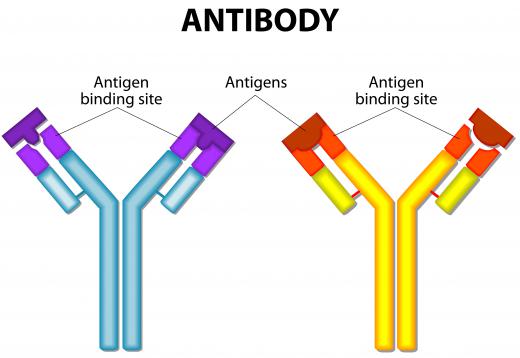What is a Peptide Antigen?
A peptide antigen is the use of a peptide to trigger an animal's immune system to develop antibodies to that peptide. Peptides are short strings of amino acids; longer chains are known as proteins. A peptide antigen may be used as part of the development of a vaccine.
Peptides are organic molecules comprised of nitrogen, oxygen, carbon, hydrogen, and usually sulfur. They are chains of amino acids and are linked by a peptide bond. Peptide bonds are linkages of the NH2 and COOH groups of the two amino acids adjacent to each other.

An antigen is a molecule that binds to an antibody and generates an immune response, the body's reaction to molecules that appear to be foreign. Not all types of molecules are capable of being recognized by the immune system. Proteins, peptides, and chains of sugars can act as antigens.
There are also human antigens. These include proteins that are present on the surface of tumor cells. Such antigens can also be present in the blood. This is the basis behind prostate-specific antigen testing, which is commonly used to screen for prostate cancer. Some antigens are intentionally introduced to act as vaccines and generate an immune response.

Antibodies are proteins in the blood that counteract a specific antigen. Only some parts of a molecule are recognized by an antibody. The tip of the antibody contains an paratope that recognizes the complex structure of the antigen. This region of the antibody is responsible for the great diversity of antibodies present in an organism. One individual can have millions of different antibodies.

Often, peptide antigens are used because they are part of a larger protein, which may not have been purified. When using a peptide antigen to make antibodies, it is important that a researcher use an antigenic section of the peptide. Antigen specialists can help with antigen design to maximize the chances that the peptide used as antigen will generate an antibody. It is much easier to predict which epitopes are exposed if one has knowledge of the three dimensional structure of the compound.
In most cases, there is no knowledge of the overall structure of the peptide, although predictive software can analyze which section of the peptide is likely to be antigenic. The peptides most likely to encounter an antibody are those on the surface of the cell. They are likely to be hydrophilic — soluble in water. Flexibility is also an important criterion for a peptide antigen to react with an epitope.
Once a suitable peptide antigen has been identified, a synthetic peptide is created. It can then be used in immunization. It is injected into an animal to generate an immune response. Once the antibodies have been isolated, they are analyzed to ensure that the organism has mounted an effective immune response.
One common way of testing to see if antibodies are specific for the desired protein is to perform a Western Blot. This involves separating the proteins that contain the peptide on a gel using an electrical current. This is called electrophoresis. Then the proteins are transferred to a membrane and probed with the antibody.
If there is antibody specific for the protein, it will bind to the protein on the membrane. The membrane is washed and then treated with a secondary antibody. If the antibodies were developed in a mouse, for example, the secondary antibody would be an anti-mouse antibody. This antibody is engineered to generate color or luminescence so the researcher can see where the original antibody has bound.
AS FEATURED ON:
AS FEATURED ON:













Discuss this Article
Post your comments